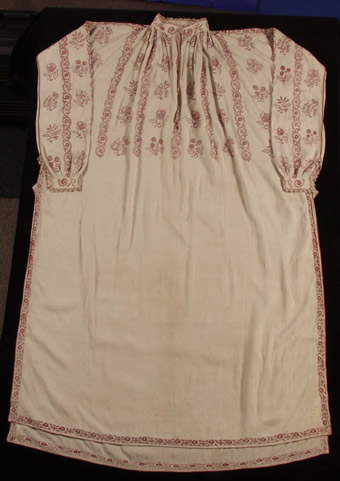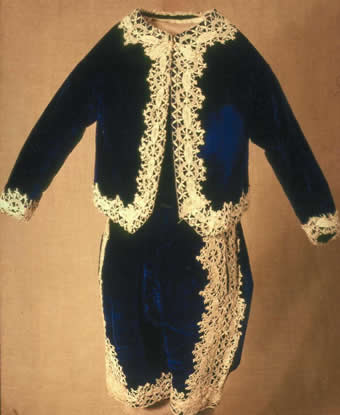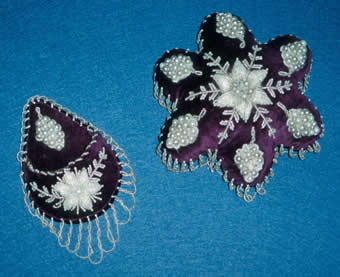Costumes and textiles
Costume and textiles
The costume and textile collection features objects dating from the 17th Century to the present day. This includes clothing worn by Warwickshire people over the last 200 years, and various textile items such as 19th Century samplers and 17th Century raised work embroidery.
Woman's costume
Dress, 1860

Women’s costume forms the main part of our collection. It includes dresses from the 18th century to the present day, with most dresses falling in the date range 1850 – 1950. There are also accessories such as hats, shoes, bags and parasols. Pictured is a dress of blue silk, trimmed with velvet ribbon, buttons and lace. It is lined with cream cotton, and the bodice front is padded for support. The full skirt is made from 10 lengths of fabric, each 43 cms wide. The hem is edged with blue wool braid.
Big skirts were popular in 1860, when this dress was made. They were often worn over a caged petticoat, or ‘crinoline’.
This dress was worn by Mary Selina Craddock for her wedding to Edward Lee, on 4 October 1860.
Men's costume

Men’s costume forms quite a small part of our collection – like many museums, we have more women’s clothes than men’s. Men’s costume includes underwear, waistcoats and smocks. There are also accessories such as hats and shoes.
The pictured shirt with cuffs, collar and front opening are edged with bobbin lace made from cream linen and red silk threads.
The shirt could have been worn either as a night shirt, or for day wear.
The embroidery was meant to be seen – either through slashes in a doublet (jacket) for day wear, or when the wearer was sitting up in bed if worn at night.
The shirt belonged to a family from Hartshill, Warwickshire.
The shirt is long and loose, with the back and front made from one piece of fabric.
The sleeves, collar, cuffs and gussets have been attached with red silk thread, using insertion stitch.
This detail on the right shows the neck and front opening of the shirt, with its narrow edging of bobbin lace.
The shirt is embroidered with a number of stylised flower and plant motifs in red silk thread.
Seven embroidery stitches are used to work the motifs – stem, buttonhole, double buttonhole, feather, fishbone, satin, and speckling stitch.
Children's costume

Children’s costume includes boy’s and girl’s clothes dating from the late 18th century to the present day. Baby clothes include long gowns, short dresses, underwear and caps. There are also a small number of accessories like hats and shoes.
Pictured is a boy’s suit of deep blue silk velvet, trimmed with cream lace. It is in three parts – jacket, breeches, and waistcoat.
It was worn by a little boy who was born at Wellesbourne, Warwickshire.
As an adult, he served with the Warwickshire Yeomanry Regiment in the Boer War in South Africa (1899 – 1902).
‘Cavalier’ suits, like this one, were popular in the 19th century.
The style really took off after the book ‘Little Lord Fauntleroy’ (a story about a boy dressed as a small cavalier) was published in 1886.
Suits like this would have been worn for parties and other special occasions.
Textiles

As well as costume, our collection also includes a wide variety of textiles.
These range from flat textiles such as quilts and samplers, to textile objects like the pocket and pincushion pictured on the left.
There are a small number of 17th Century embroidered items, including a casket and several raised work panels.
The image shows a purple silk velvet pin cushion and matching hanging pocket, decorated with white beads and mock pearls.
Items like these could be bought, or made at home. In the 19th Century, magazines like ‘The Englishwoman’s Domestic Magazine’ showed readers how to make various needlework objects.
The pocket could be hung on a dressing table, to store a watch in overnight.




